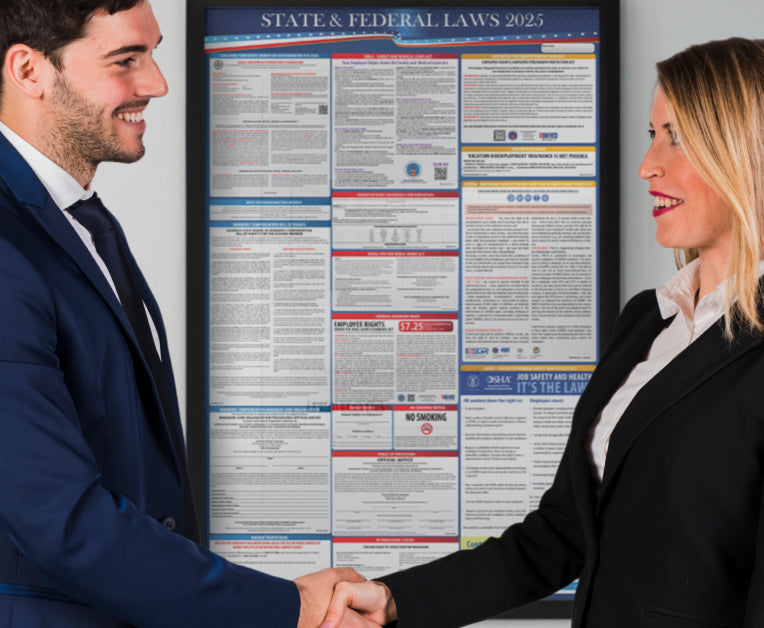
What Happens During a Labor Law Poster Inspection?
Labor law posters are not optional décor—they are a legal requirement that every employer must take seriously. While most businesses understand the need to display them, many underestimate the importance of compliance until an inspection takes place. But what exactly happens during a labor law poster inspection? How thorough is the process, and why does it matter so much?
In this in-depth guide, we’ll walk through everything employers need to know about labor law poster inspections: what triggers them, what inspectors check, the consequences of failing, and most importantly, how to stay fully compliant with minimal stress.

Why Labor Law Poster Inspections Exist
Government agencies do not conduct inspections simply to add red tape. The goal is to ensure that employees have access to their workplace rights in a clear, visible way. By law, labor law posters must be displayed prominently where workers can see them daily.
This requirement exists to protect employees and prevent disputes before they arise. If workers understand their rights—whether related to wages, safety, family leave, or discrimination—they are less likely to fall victim to violations or misunderstandings.
For employers, this means inspections are less about punishment and more about accountability. They are a reminder that compliance with workplace laws begins with proper communication.
If you’re interested in how posters directly reduce conflicts, you can explore the role of labor law posters in preventing workplace disputes.
What Triggers a Labor Law Poster Inspection?
Inspections don’t happen at random. Several scenarios may trigger them:
- Routine compliance checks – Agencies like the Department of Labor may include poster inspections as part of regular workplace audits.
- Employee complaints – If a worker feels their rights are not properly displayed, they can report the employer.
- Investigations into other violations – If your business is already under review for wage issues, safety hazards, or HR compliance matters, poster visibility will likely be included.
- High-risk industries – Certain sectors, such as construction or manufacturing, tend to face more frequent inspections due to higher employee safety concerns.
In any case, once inspectors arrive, labor law poster compliance is one of the first and easiest things they can check.
Step-by-Step: What Inspectors Look For
When an inspector examines your workplace, the process is surprisingly structured. Here’s what typically happens:
1. Poster Placement
The first and most obvious check is whether posters are displayed where employees can easily see them. Break rooms, common hallways, or near time clocks are acceptable. Keeping them in a manager’s office or a locked HR file does not meet the requirement.
2. Poster Visibility and Condition
Inspectors check for posters that are legible, intact, and not hidden behind bulletin boards or faded with age. Torn or outdated posters will not pass.
3. Federal Posters
Every workplace must display federal labor law posters, including notices for minimum wage, family medical leave, equal employment opportunity, and occupational safety. Inspectors confirm each required notice is present.
4. State Posters
Each state has its own set of labor laws, and inspectors verify that businesses have displayed the correct ones. For example, wage rates, child labor rules, or state-specific leave policies.
5. Industry-Specific Posters
Some industries, such as government contractors or transportation, require additional postings. Inspectors confirm that these unique obligations are met.
6. Language Requirements
If your workforce includes employees who primarily speak another language, inspectors will check whether posters are displayed in those languages.
Failing any of these checks can result in citations or penalties.
What Happens If You Fail a Labor Law Poster Inspection?
The consequences of failing an inspection vary depending on the severity of the violation. Common outcomes include:
- Warnings and deadlines – For first-time or minor issues, inspectors may issue a warning and give you time to correct it.
- Fines and penalties – More serious or repeated violations can lead to financial penalties, which may reach thousands of dollars depending on the law violated.
- Increased scrutiny – Non-compliance often leads to closer monitoring in the future.
- Employee disputes – If employees realize posters were missing, they may feel their rights were intentionally withheld, leading to grievances or legal disputes.
In short, non-compliance doesn’t just bring financial costs—it can damage workplace trust and employer reputation.
How to Prepare for a Poster Inspection
Smart employers prepare before inspectors ever arrive. Here are the key strategies to stay inspection-ready:
Keep Posters Updated Regularly
Labor laws change frequently, sometimes multiple times a year. Wage rates adjust, safety standards evolve, and new policies are introduced. Relying on outdated posters is one of the most common compliance failures.
To avoid this, businesses use services like poster updates, which automatically provide the latest notices as laws change.
Ensure Posters Are in the Right Location
Posters should be placed where employees naturally gather—not tucked away. If you operate multiple facilities, every location must have its own set.
Cover Both Federal and State Requirements
Many businesses mistakenly believe federal posters are enough. In reality, state posters are equally mandatory. Using complete labor law posters designed for your state eliminates guesswork.
Address Industry and Language Needs
If you employ a multilingual workforce or fall under special industry laws, ensure your posters reflect those requirements.
Consider Centralized Compliance Solutions
For larger employers or multi-state corporations, managing poster compliance can feel overwhelming. In such cases, corporate solutions help businesses streamline compliance across all locations.
The Role of Poster Inspections in HR Compliance
Poster inspections are not just about checking boxes. They are a central part of HR compliance. An inspector’s report can reveal whether an employer truly values transparency and fairness.
For a deeper perspective, you may want to read the connection between HR compliance and labor law posters. It explains how these simple posters play a major role in preventing legal disputes and demonstrating good-faith compliance.
Why Employers Should Welcome Inspections
While inspections can feel intimidating, they actually offer benefits:
- They highlight areas of improvement.
- They reduce long-term liability.
- They protect your business from employee lawsuits.
- They confirm your compliance efforts are effective.
Employers who stay ready rarely have anything to worry about when inspectors arrive. Instead, inspections serve as confirmation that their compliance strategies are working.
Making Poster Compliance Simple

If inspections sound stressful, remember that compliance doesn’t need to be complicated. By using updated, all-in-one posters, monitoring changes, and relying on professional update services, employers can eliminate guesswork entirely.
The right partner ensures that your business is always prepared—whether an inspector arrives tomorrow or next year.
A labor law poster inspection is not a trap. It’s an accountability measure designed to protect workers and guide employers. Inspectors look for visibility, accuracy, and compliance with both federal and state laws. Failing to meet those standards can lead to warnings, fines, and unnecessary risk.
The good news is that compliance is simple when approached proactively. With the right posters, reliable update services, and corporate solutions, employers can remain inspection-ready at all times.
Labor law posters are more than legal requirements—they are daily reminders of workplace rights, compliance, and transparency. Inspections only reinforce what every employer should already know: keeping posters updated and visible is one of the easiest ways to protect both employees and your business.


